The 2005 California rafting season is heading into its eighth week. Trips have been exciting and beautiful. Rivers have had excellent flows due to occasional rain and snowmelt. Canyons are green and lush and have more wild flowers than we have seen in years.
Cooler temperatures have kept the heavy winter snowpack and higher elevations intact and this week it will begin to melt due to a warm climate change and less cloud cover. Deep snow in the Sierra is poised and waiting for the first significant heat of spring and summer. The big water 2005 rafting season is about to take off! Flows will increase dramatically starting this weekend and will stay high for weeks. You won’t want to miss the thrill of this season.
Seasonal predictions are based on snowpack, reservoir storage, and expected weather patterns, and can change. The measurement used to determine the flow in a river is “CFS”, which is cubit feet per second. Most of the time, higher flows (higher CFS) means more exciting and demanding rafting trips.
The following predictions were posted May 12, 2005 at 5:45PM.
Click on your favorite river below to find out when might the best time for you to book to your California rafting trip!
Intermediate-Advanced
South Fork American River (Beginner / Class III): 127% of average runoff
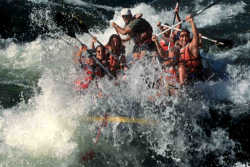 California's most popular river!
California's most popular river!
The South Fork of the American is always a great place for good fun and good whitewater. It is conveniently located and allows for a large variety of trip options. It also has lots of rapids per mile, especially during times of high water. And high water it will be in 2005! From now until late-June, the South Fork will be flowing between 3000 and 6000 cubit feet per second (cfs). By comparison, normal flow is 1200-1500cfs. So if you want to experience fast water with big waves one after another, set some time aside to join us on the South Fork this spring. After June the river will rely on releases from seven upstream reservoirs for flows until early October. Due to the good winter snowpack, these reservoirs will release higher than normal flows (1700cfs) through the summer and into the fall.
Middle Fork American River (Intermediate / Class III-IV): 127% of average runoff
 Wilderness and a taste of Class IV rafting!
Wilderness and a taste of Class IV rafting!
The Middle Fork provides a wonderful introduction to Class IV Intermediate whitewater. It flows through a beautiful and remote scenic canyon more than 2000 feet deep and makes for a great 1- 2- or 3-Day rafting trip. In years of above-average snowpack, the Middle Fork can become too high to run all of the challenging rapids. Necessary trip modifications during periods of high water make this trip less than desirable. We believe this high water time will occur from Memorial Day Weekend (May 28) through June 12, and we won’t be offering trips during this time. However, before May 28, and after June 12, the river will be running very well 7 days a week up until early October. We will be able to enjoy this extended season because the two reservoirs above the Middle Fork are full this year.
Merced River (Intermediate / Class III-IV): 158% of average runoff
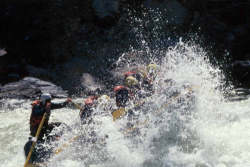 Natural Roller Coaster Ride Just Outside Yosemite!
Natural Roller Coaster Ride Just Outside Yosemite!
The Merced River has no man-made dams or reservoirs above its whitewater run, so in years like this, when we have a big snowpack, it runs very high in the spring and flows well into summer. Run-off for this river is expected to be higher than any other river in California! If you have never tried Class IV rafting, the Merced is the perfect way to give it a shot this spring. Flows will be high (5000-8000) and should peak near 10000 in early June and remain high (above 3000 cfs) for the rest of the month. If you are an adrenaline junkie you can get your fix during high water on the Merced -- you will not believe how fast the river travels, how big the waves are, and how much fun you’ll have on one of these trips. By July, the river will begin a slow decline in flow until August when it will become too low to raft.
Tuolumne River (Intermediate – Advanced / Class IV+): 151% of average runoff
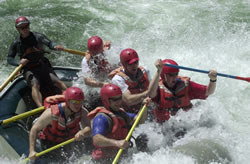 Wild, Powerful Whitewater in a Magnificent Wilderness Setting!
Wild, Powerful Whitewater in a Magnificent Wilderness Setting!
The Tuolumne River always has good whitewater! This is particularly true in years like 2005 when there is a deep snowpack. For the rest of May until early July, the river will spike up and down between high (5000 to 8000cfs) and very high levels (8000 to 12000cfs). Don’t sign up for a trip during this time unless you enjoy being on the edge and pushing personal limits. At these extreme flows the “T” becomes a monster, and many experienced rafters believe it is the most powerful whitewater river in the west. Big waves, sucking holes, long rapids, and must-miss obstacles create a trip best suited for aggressive and very adventurous people. After mid-July, the river will drop to healthy summer releases from three upstream reservoirs seven days a week and will remain 1500 to 1800cfs until August 22 when turbine work is scheduled on upstream dams. The Tuolumne will have a very sweet season that will end about two weeks earlier than normal due to hydro electrical work.
North Fork Stanislaus (Intermediate – Advanced / Class IV+): 145% of average runoff
 Scenic high elevation river with technical Class IV rafting!
Scenic high elevation river with technical Class IV rafting!
The North Stan is one of the most beautiful rivers in California. The scenery alone is worth the trip. The unusual high elevation of this run (4000 feet) means we literally raft through the forest, compete with giant pines and blooming wild azaleas. Add lots of technical whitewater and you have a very satisfying run for experienced rafters.
Normally the season on this amazing river is short and only lasts from late April until mid-May. The heavy 2005 snowpack will allow for trips to take place this year until mid-June. Flows will be very good between 500 and 1200cfs, and will be held in check by a dam above the run that catches most of the snowmelt and releases it into the river during the summer at night.
Kaweah River (Intermediate – Advanced / Class IV+): 138% of average runoff
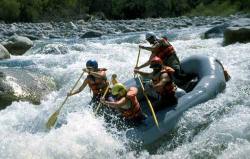 Whitewater Expressway next to Sequoia National Park!
Whitewater Expressway next to Sequoia National Park!
The Kaweah is known for its whitewater... one long rapid after another separated by short swift calms. If action is what you want, the Kaweah will deliver. This is particularly true this year since the snowpack in the southern part of the state is deep and wide.
Beginning this week the river will reach high levels between 2000 and 3500cfs and will present whitewater enthusiasts with a very challenging run. These high water conditions will continue through most of June as snow from several 13000-foot peaks melts and finds its way into the river. Anyone on a high water Kaweah trip should have previous rafting experience and be aggressive…just staying in the raft can be difficult at these flows! By the end of June flows will decrease until late-July when winter snows have melted and the river becomes too low to run.
North Fork American River (Intermediate – Advanced / Class IV+): 127% of average runoff
 Fast, technical whitewater in a narrow canyon!
Fast, technical whitewater in a narrow canyon!
The North Fork is the most difficult river in the American River drainage. The first six miles of this beautiful stretch of river travels through Chamberlain Falls Gorge, a narrow rock walled corridor full of big drops, big boulders, and big fun. There are no dams above the run so the river flows best when snows upstream are melting.
Towards the end of this week the 2005 snowmelt will begin and flows will start to climb above 2000 and reach levels as high as 3500cfs. By early June the river will drop to more normal flows of 1200-2000, and by mid-June the river will be too low to run. This trip is best for those with previous rafting experience and who do not mind running into tough Class IV rapids within a few minutes of the trip start.
California Salmon River (Advanced / Class V): 100% of average runoff
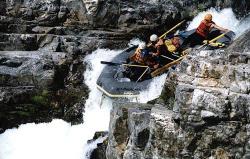 Remote Class V rafting in a temperate rainforest!
Remote Class V rafting in a temperate rainforest!
The “Cal-Salmon” is a great place to try Class V rafting for the first time if you do not mind driving to the north west corner of the state. The river travels through a narrow canyon with high granite cliffs on both sides. The scenery is spectacular and the rapids are powerful and violent.
Only those with a thirst for challenge and previous Class IV rafting should attempt this trip. This year snow and rainfall in the area was average, so flows will be normal (1200 to 2500cfs). There are no dams above this run; therefore trips will be available when snow is melting until about mid-June.
Cherry Creek (Advanced / Class V+): 151% of average runoff
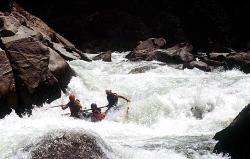 Considered the most difficult commercial rafting trip in the U.S.!
Considered the most difficult commercial rafting trip in the U.S.!
Cherry Creek is not a place for the faint at heart. It contains some of the most difficult rapids in the country. There are over 15 Class V rapids on this 9-mile run and many more Class IV drops. Adrenaline levels are kept high all day long as we move from one challenging rapid to another. As we travel downstream rapids get longer, more difficult, and closer together. Only those seeking the ultimate whitewater challenge should attempt this run. We need water levels between 1000 and 2000cfs to do this trip.
This year the river will be too high to run until late July. By August 22 flows will be shut off due to scheduled maintenance on upstream dams. The need to “wait” for water to drop to the right level, and the lack of water after August 22, means the season for this advanced run this year will only last for three to four weeks.